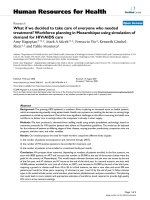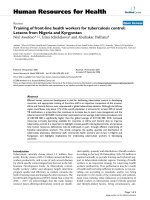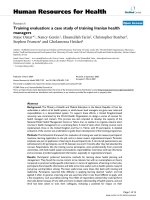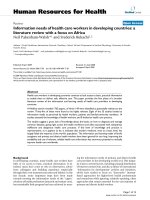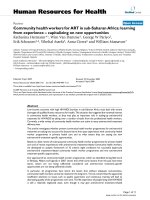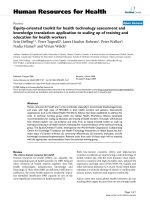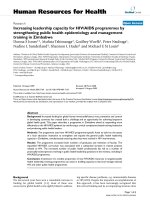báo cáo sinh học:" Training needs assessment for clinicians at antiretroviral therapy clinics: evidence from a national survey in Uganda" docx
Bạn đang xem bản rút gọn của tài liệu. Xem và tải ngay bản đầy đủ của tài liệu tại đây (301.38 KB, 8 trang )
BioMed Central
Page 1 of 8
(page number not for citation purposes)
Human Resources for Health
Open Access
Research
Training needs assessment for clinicians at antiretroviral therapy
clinics: evidence from a national survey in Uganda
Ibrahim M Lutalo
†1
, Gisela Schneider
†2
, Marcia R Weaver*
†3
,
Jessica H Oyugi
4
, Lydia Mpanga Sebuyira
1
, Richard Kaye
5
, Frank Lule
6
,
Elizabeth Namagala
7
, W Michael Scheld
8
, Keith PWJ McAdam
1,9,10
and
Merle A Sande
11
Address:
1
Infectious Diseases Institute, Makerere University, Kampala, Uganda,
2
DIFAEM – German Institute of Medical Mission, Tuebingen,
Germany,
3
Department of Global Health and International Training and Education Centre on HIV (I-TECH), University of Washington, Seattle
WA, USA,
4
Coordinating Center for Infectious Diseases, Centers for Disease Control and Prevention, Lilongwe, Malawi,
5
African Palliative Care
Association, Kampala, Uganda,
6
Regional Office for Africa, World Health Organization, Brazzaville, Congo,
7
Ministry of Health, Kampala,
Uganda,
8
Department of Internal Medicine, University of Virginia, Charlottesville VA, USA,
9
Department of Clinical Tropical Medicine, London
School of Hygiene and Tropical Medicine, London, UK,
10
Pratt Medical Group, Tufts-New England Medical Center, Boston MA, USA and
11
Formerly of the Department of Medicine, University of Washington, Seattle, WA, and the Accordia Global Health Foundation, Arlington, VA,
USA
Email: Ibrahim M Lutalo - ; Gisela Schneider - ; Marcia R Weaver* - ;
Jessica H Oyugi - ; Lydia Mpanga Sebuyira - ; Richard Kaye - ;
Frank Lule - ; Elizabeth Namagala - ; W Michael Scheld - ;
Keith PWJ McAdam - ; Merle A Sande -
* Corresponding author †Equal contributors
Abstract
Background: To increase access to antiretroviral therapy in resource-limited settings, several experts recommend
"task shifting" from doctors to clinical officers, nurses and midwives. This study sought to identify task shifting that has
already occurred and assess the antiretroviral therapy training needs among clinicians to whom tasks have shifted.
Methods: The Infectious Diseases Institute, in collaboration with the Ugandan Ministry of Health, surveyed health
professionals and heads of antiretroviral therapy clinics at a stratified random sample of 44 health facilities accredited to
provide this therapy. A sample of 265 doctors, clinical officers, nurses and midwives reported on tasks they performed,
previous human immunodeficiency virus training, and self-assessment of knowledge of human immunodeficiency virus and
antiretroviral therapy. Heads of the antiretroviral therapy clinics reported on clinic characteristics.
Results: Thirty of 33 doctors (91%), 24 of 40 clinical officers (60%), 16 of 114 nurses (14%) and 13 of 54 midwives (24%)
who worked in accredited antiretroviral therapy clinics reported that they prescribed this therapy (p < 0.001). Sixty-four
percent of the people who prescribed antiretroviral therapy were not doctors. Among professionals who prescribed it,
76% of doctors, 62% of clinical officers, 62% of nurses and 51% of midwives were trained in initiating patients on
antiretroviral therapy (p = 0.457); 73%, 46%, 50% and 23%, respectively, were trained in monitoring patients on the
therapy (p = 0.017). Seven percent of doctors, 42% of clinical officers, 35% of nurses and 77% of midwives assessed that
their overall knowledge of antiretroviral therapy was lower than good (p = 0.001).
Conclusion: Training initiatives should be an integral part of the support for task shifting and ensure that antiretroviral
therapy is used correctly and that toxicity or drug resistance do not reverse accomplishments to date.
Published: 23 August 2009
Human Resources for Health 2009, 7:76 doi:10.1186/1478-4491-7-76
Received: 7 June 2008
Accepted: 23 August 2009
This article is available from: />© 2009 Lutalo et al; licensee BioMed Central Ltd.
This is an Open Access article distributed under the terms of the Creative Commons Attribution License ( />),
which permits unrestricted use, distribution, and reproduction in any medium, provided the original work is properly cited.
Human Resources for Health 2009, 7:76 />Page 2 of 8
(page number not for citation purposes)
Background
Considerable progress continues towards increasing
access to anti-retroviral therapy (ART) in resource-limited
settings. WHO, UNAIDS and UNICEF recently estimated
that 2.12 million people have access to ART in sub-Saha-
ran Africa, or 30% of people with HIV living there who
need ART [1]. These accomplishments required training of
health professionals, among other efforts to strengthen
health systems. For example, the United States President's
Emergency Plan for AIDS Relief supported the training or
retraining of 219 700 health professionals in ART from
2004 to 2008 [2].
The greatest challenge to increasing access to ART, how-
ever, is the shortage of trained health care professionals
[1,3-5]. Several experts recommend "task shifting" from
doctors to clinical officers and nurses [6-9] or from clini-
cians to community health workers [8-10]. According to
WHO, task shifting is the rational redistribution of tasks
among health workforce teams:
"Specific tasks are moved, where appropriate, from
highly qualified health workers to health workers with
shorter training and fewer qualifications in order to
make more efficient use of available human resources
for health." [8]
Gimbel-Sherr et al. demonstrated that expanding the role
of nurses allowed doctors to have more visits with ART-
eligible patients at two clinics in Mozambique [11]. Last
year, they compared ART patients treated by non-physi-
cian clinicians to those treated by doctors, and reported
that the quality of services provided by non-physician cli-
nicians was equivalent to or slightly better than that of
doctors [12]. Recent articles report on clinical officers
and/or nurses providing ART in Kenya [13,14], Malawi
[15], Rwanda [16] and Zambia [17,18].
In 2008, WHO published global recommendations and
guidelines for task shifting that would promote access to
HIV and other health care services [8]. Recommendation
Four is that countries undertake or update a human
resource analysis on the extent to which task shifting is
already taking place, among other things. Recommenda-
tion Nine is that countries adopt a systematic approach to
harmonized, standardized and competence-based train-
ing that is needs-driven and accredited. The Infectious
Disease Institute (IDI), in collaboration with the Ministry
of Health (MOH) of Uganda, recently conducted a train-
ing needs assessment that addressed both of these recom-
mendations. Information was collected on the allocation
of ART tasks across health professionals. An audience
analysis [19] provided background on previous training
and self-assessment of HIV and ART knowledge.
Uganda was chosen for its well-developed national ART
programme and mature training environment for HIV
care. As of September 2007, an estimated 111 232 people
had access to ART, or 33% of people in need [1]. Uganda
also was a pioneer in training nurses to perform some
tasks of doctors, and lay health workers to perform some
tasks of nurses [20,21]. Health professionals benefited
from several ART training initiatives, including the Drug
Access Initiative [20], and WHO's Integrated Management
of Adult and Adolescent Illness [21], as well as training
from organizations such as the Joint Clinic Research Cen-
tre, HealtheFoundation [22], IDI [20,22,23], Mildmay
International [20,22], Paediatric Infectious Diseases
Clinic at Mulago Hospital, The AIDS Support Organiza-
tion (TASO) [22], and Uganda Cares. These organizations
trained a variety of health professionals with courses last-
ing from one day to 21 days.
This assessment contributes a method for identifying task
shifting that has occurred in resource-limited settings and
measuring the ART training needs associated with it to the
literature on ART training needs. Previously, the Center
for African Family Studies and Regional AIDS Training
Network conducted an HIV/AIDS training needs assess-
ment in 12 countries in 2002 that predated scaling-up of
ART (Marc Ahmed Okunnu, personal communication, 10
August 2009). Renggli conducted a situational analysis in
Africa that focused on organizations that provided train-
ing in clinical management of HIV infection, including
ART [20]. Souville et al. reported on knowledge of and
attitudes about ART among physicians in Cote d'Ivoire
[24], and Dohrn et al. reported on knowledge of ART
among midwives in South Africa [25]. The innovative
method presented below can be replicated to inform ART
training programmes in the context of on-going scale-up
and shifting tasks.
Methods
Study design
We surveyed health professionals and heads of ART clinics
at a cross-section sample of clinics that the MOH had
accredited to provide ART. Health professionals reported
on the tasks they performed during a normal work day,
previous HIV training and overall knowledge of HIV and
ART. Knowledge was rated on a six-point scale, where one
was "excellent" and six was "none." The heads of ART clin-
ics reported on the staff and patients at the HIV and ART
clinic.
Sampling procedure and sample size
We sought a nationally representative sample of accred-
ited ART clinics in Uganda. The Ugandan health system
divides the country into 11 catchment areas of the
regional referral hospitals. Each area serves several dis-
tricts. The national referral hospital in Kampala is the
Human Resources for Health 2009, 7:76 />Page 3 of 8
(page number not for citation purposes)
twelfth area; it was excluded from the assessment, because
IDI sought information to guide training programmes for
health professionals outside of Kampala. Using a lottery
method, the following six areas were selected: Arua, Lira,
Masaka, Hoima, Kabale and Mbale.
Using proportionate allocation to size sampling method,
a sample 44 of the 205 accredited facilities as of July 2006
was selected. According to the Ministry of Health, (per-
sonal communication, MOH, National Medical Stores,
2006), 12% of the accredited ART clinics in the six catch-
ment areas were regional referral hospitals, 35% were dis-
trict hospitals, and 54% were health centre IV or III. The
sample included six regional referral hospitals (14%), 16
district hospitals (34%), and 22 health centre IV or III
(52%).
In each catchment area, a random sample of facilities was
selected from a MOH list of accredited ART clinics, strati-
fied by type of facility. The two strata were: ownership
(government or nongovernmental organization and/or
faith-based organization) and whether or not the facility
was active, i.e. providing ART. Three government district
hospitals were selected randomly from each of the four
catchment areas of the biggest administrative regions and
two from each of the others. One facility that was not
active was selected from each catchment area. At least one
nongovernmental or faith-based facility was selected from
each catchment area, including six hospitals and four
health centres. Two remote facilities were replaced with
proximate ones to stay within the bounds of the study
schedule and budget.
Within health facilities, a convenience sample of health
professionals was selected with the help of the head of the
ART clinic. The inclusion criterion was any person provid-
ing services at the accredited ART clinic who was at the
facility on the day that the study team visited (see below).
We sought to include at least one doctor, clinical officer,
nurse and midwife from each clinic. In Uganda, a doctor
has secondary school education (13 years), five years of
medical school and one year of internship. Clinical offic-
ers are among the non-physician clinicians described in a
recent review [26]; they have a secondary school educa-
tion, three years of pre-service training and two years of
internship. There are several types of nurses: all have a sec-
ondary school education; (1) enrolled nurse and enrolled
midwives have one and one-half years of pre-service train-
ing; (2) comprehensive nurses, registered nurses and reg-
istered midwives have three years of pre-service training;
and (3) double-trained nurse-midwives have four and
one-half years of pre-service training.
Data collection procedures
Data were collected by means of self-administered ques-
tionnaires for individual health professionals and face-to-
face interviews with heads of ART clinics as key inform-
ants. The questionnaires were designed based on exam-
ples from the National Evaluation Center of the United
States AIDS Education and Training Centers. (See http://
aetcnec.ucsf.edu/nec?page=eval-00-00) The questionnaire
for individual health professionals had six sections on (1)
professional background, (2) provision of HIV/AIDS serv-
ices, (3) training in HIV/AIDS, (4) barriers to training, (5)
attendance at IDI courses, and (6) IDI's AIDS Treatment
Information Center. The questionnaire for the head of the
ART clinic had similar sections, but only the responses to
questions about staff and patients at the HIV and ART
clinics were used in the analysis.
Early versions were shared with stakeholders representing
HIV training organizations in Uganda in a participatory
process that led to several improvements. Later versions of
the questionnaires were pretested with health profession-
als and the head of the ART clinic at Mbuya Reach Out and
a Kampala City Council clinic. The final questionnaire for
health professionals is included as Additional file 1; the
questionnaire for the head of the ART clinic is available
from the authors on request.
Twelve research assistants were trained in data collection
for three days. They were grouped into four teams, each
comprising a social scientist, medical doctor and field
assistant. A team spent one day at each facility and col-
lected data from an average of 11 facilities during a two-
week period in July and August 2006.
Data management and analysis
The completed questionnaires were coded and the data
were double-entered in Epi-Info version 6.01 software
(Centers for Disease Control and Prevention, Atlanta GA,
United States of America) to ensure accuracy and integrity
of the data. Descriptive statistics and statistical tests were
conducted with SPSS-PC software, version 11.0 for Win-
dows (SPSS Inc, Chicago IL, United States of America).
Data analyses were stratified by health profession and chi-
square (χ
2
) tests were used to assess statistical significance
of differences in proportions (percentages). Where there
were a small number of cases (expected frequency less
than 5); Fisher's exact tests were used.
Human subjects
The study was approved by the IDI training committee,
the MOH and the Institutional Review Board of the Fac-
ulty of Medicine at Makerere University. Respondents pro-
vided oral informed consent.
Human Resources for Health 2009, 7:76 />Page 4 of 8
(page number not for citation purposes)
Results
Characteristics of the sample
Forty-three of the 44 facilities selected were included; a
team was unable to travel to one nongovernmental health
centre that was not active. Thirty-eight of the 43 health
facilities were active and five (one district hospital and
four health centre IVs) were not. As shown in Figure 1, the
regional referral hospitals provided ART to an average of
1727 HIV patients per month, whereas the district hospi-
tals and health centre IV provided ART to an average of
228 and 78 people, respectively. Regional referral hospi-
tals reported the highest proportion of HIV patients
receiving ART (45%), while 33% and 17% of HIV patients
received ART at district hospitals and health centre IVs,
respectively.
The sample of health professionals included 265 clini-
cians: 34 were doctors, 46 clinical officers, 124 nurses and
61 midwives. Sixty percent were female and 58% were
aged 35 years or younger. Table 1 compares the respond-
ents to the staff that the head of the ART clinics reported
were assigned to the ART clinics. The distribution of
respondents across health professions differed signifi-
cantly from the distribution of staff assigned to the ART
clinics. Doctors were underrepresented at all types of facil-
ities; nurses were underrepresented at regional referral
hospitals and district hospitals and overrepresented at
health centre IVs. No doctors were on the staff of ART clin-
ics at two district hospitals and two health centres.
Allocation of tasks by health profession
ART tasks were performed by all types of clinicians, as
shown in Table 2. Thirty of 33 doctors (91%), 24 of 40
clinical officers (60%), 16 of 114 nurses (14%) and 13 of
54 midwives (24%) who worked in accredited ART clinics
reported that they prescribed ART (p < 0.001). Of the 83
people who prescribed ART, only 36% were doctors; 29%
were clinical officers, 19% nurses and 16% midwives. On
a normal working day, nurses reported spending more
than the average number of hours prescribing ART and
midwives reported spending less. Consequently, of the
234 hours devoted to prescribing ART, 36% were by doc-
tors, 30% by clinical officers, 24% by nurses and 9% by
midwives.
HIV training
Eighty-six percent of respondents reported they had
attended at least one HIV training session, and percent-
ages did not differ significantly across health professions
(p = 0.242). The median duration of training varied across
topics from three days for infection control to 21 days for
HIV research. The median duration of training in initiat-
ing ART was seven days, and also seven days in monitor-
ing ART.
The percentage of people with training in specific topics
differed significantly across health professions, as shown
in Additional file 2. Seventy-one percent of doctors and
54% of clinical officers attended training on initiating
ART, compared to 54% of nurses and 40% of midwives (p
< 0.001). Higher percentages of doctors and clinical offic-
ers attended training on monitoring ART (p = 0.001) and
paediatric HIV care (p = 0.023) than nurses and midwives.
Conversely, lower percentages of doctors and clinical
officers attended training on voluntary counselling and
testing (p = 0.003) than nurses and midwives.
Focusing on ART training among respondents who
reported that they prescribed ART, 24% of doctors, 38% of
clinical officers, 38% of nurses and 49% of midwives had
no training in initiating patients on ART (p = 0.457).
Twenty-seven percent of doctors, 54% of clinical officers,
50% of nurses and 77% of midwives had no training in
monitoring patients on ART (p = 0.017).
Self assessment of HIV and ART knowledge
Health professionals were asked to rate their overall
knowledge of HIV and overall knowledge of ART. Ratings
of "excellent," "very good," and "good" were grouped
together as "sufficient;" 75% of the respondents assessed
that their overall knowledge of HIV was sufficient and
40% rated their overall knowledge of ART as sufficient. As
shown in Figure 2, there were significant differences in
ART knowledge across professions.
Respondents' self-assessment of their ART knowledge was
significantly related to training in initiating and monitor-
ing ART. Twenty-two percent of 66 who rated their knowl-
edge of ART as less than good had training on initiating
ART; 70% of 199 who rated their knowledge as sufficient
had training (p < 0.001). Similarly, 16% of 159 who rated
their knowledge of ART as less than good had training on
monitoring ART; 54% of 106 who rated their knowledge
as sufficient had training (p < 0.001). These measures
were significantly related within health professions in
seven out of eight comparisons.
Discussion
Access to ART in Uganda has extended beyond specialized
urban clinics to district hospitals and primary care facili-
ties. Although the percentage of HIV patients receiving
ART was higher at regional referral hospitals (45%) than
at district hospitals (33%) and health centre IVs (17%),
the percentages may even out over time if HIV patients
transfer their care to accredited facilities closer to their
homes.
Uganda's well-developed ART programme was staffed by
a broad range of health professionals. Sixty-four percent
of professionals who prescribed ART were clinical officers,
Human Resources for Health 2009, 7:76 />Page 5 of 8
(page number not for citation purposes)
nurses or midwives. This task-shifting followed the rec-
ommendations of experts and may have contributed to
extending access to ART.
Training on initiating and monitoring ART had not, how-
ever, always kept pace with task shifting. Although the
majority of people who prescribed ART had attended
training on initiating and monitoring ART, 35% of
respondents had not attended training on initiating ART
and 49% on monitoring ART. The percentages of people
who prescribed ART who had attended no training on
monitoring ART were significantly different across health
professions: 27% of doctors had no training on monitor-
ing ART, compared to 64% of other clinicians. Similarly,
self-assessments of knowledge of ART differed signifi-
cantly across professions; 7% of doctors who prescribed
ART reported their overall knowledge of ART was lower
than "good", compared with 48% of other clinicians. The
criteria for a health facility to be accredited to provide ART
in Uganda included that a minimum number of health
professionals were qualified with experience in HIV/AIDS
management [20], but the staff of the ART clinics may
have changed over time.
This is the first article to document task shifting and train-
ing needs across a range of health professionals. Other
assessments of a range of health professionals did not
document responsibilities for HIV care. Liljestrand
reported significant differences in HIV training across pro-
fessions in the United States; for example, registered
nurses had less ART training than doctors, physician
assistants and nurse practitioners [27]. The multidiscipli-
nary training needs assessment by the Center for African
Family Studies and Regional AIDS Training Network con-
cluded that the two most critical training gaps for doctors,
clinical officers and nurses were the same, but it was based
on expert opinion rather than self-assessment (Marc
Ahmed Okunnu, personal communication, 10 August
2009).
Training needs as measured by previous training and self-
assessment of knowledge provided similar results and the
measures were significantly related. A review of studies of
health professionals in the United States and Europe con-
cluded that the validity of self-assessment of performance
was low to moderate, but could be improved with appro-
priate training [28]. Others recommended assessment
based on more objective measures of competence [29].
Our results suggested that self-assessment of overall
knowledge of ART was a valid measure of basic ART train-
ing needs in a resource-limited setting. Future research on
detailed training needs may use diaries in which health
professionals note difficult situations during encounters
with patients [30].
Average number of registered people living with HIV/AIDS, and ART patients in the facilityFigure 1
Average number of registered people living with
HIV/AIDS, and ART patients in the facility.
0
500
1,000
1,500
2,000
2,500
3,000
3,500
4,000
Over all RRH DH HC IV
1,104
3,814
690
450
398
1,727
228
78
No of patients
PLWHA Registered at Facility PLWHA on ART at Facility
Table 1: Comparison of respondents and all health professionals in the sample of ART clinics
Cadre Total Regional referral hospital District hospital Health centre IVs
Respondents
(n = 265)
%
Staff reported
by head of
clinic
(n = 392)
%
Respondents
(n = 54)
%
Staff reported
by head of
clinic
(n = 81)
%
Respondents
(n = 101)
%
Staff reported
by head of
clinic
(n = 158)
%
Respondents
(n = 110)
%
Staff reported
by head of
clinic
(n = 153)
%
Doctor 13 19 22 28 14 20 7 14
Clinical Officer 17 21 11 19 17 18 21 26
Nurse 4744414847535033
Midwife 23 15 26 5 23 9 22 27
p-value 0.014 0.005 0.017 0.033
Human Resources for Health 2009, 7:76 />Page 6 of 8
(page number not for citation purposes)
Limitations
The health professionals were a convenience sample of
those who were at a nationally representative sample of
accredited ART clinics on the day of the study. Conse-
quently, the sample overrepresented some types of profes-
sionals at some facilities and underrepresented others;
doctors were underrepresented at all facilities. The sample
may have reflected the time doctors allocated to ART care
more accurately than administrative records; higher rates
of absenteeism among doctors have also been reported
previously [31].
Of the 45 facilities in the nationally representative sam-
ple, two remote facilities were replaced with ones that
were easier to reach; a team was unable to travel to one
facility. To the extent that task shifting was more likely to
occur in remote facilities and health professionals in those
facilities were less likely to be trained, the sample may
have underestimated the extent of task shifting and ART
training needs associated with it.
Table 2: Allocation of tasks in ART clinics by profession
Doctor Clinical Officer Nurse Midwife
Tasks n = 33 n = 40 n = 114 n = 54 Bivariate analysis
%%%%χ
2
dF p-value
Clinical care
Prescribing ART 90.9 60 14 24.1 82.89 3 <0.001*
Prescribing other medicines 100 90 43.9 57.4 42.13 3 <0.001*
Providing basic HIV care 69.7 70 58.8 50 6.04 3 0.152
Nursing care and counselling
Counselling clients 54.5 52.5 71.9 90.7 24.08 3 <0.001*
Nursing care to PLWHA 15.2 15 53.5 48.1 32.72 3 <0.001*
Home visiting 12.1 20 35.1 37 10.3 3 0.022*
Other aspects
Administration/Supervisor 78.8 40 35.1 46.3 22.54 3 <0.001*
Training other health professionals 54.5 15 9.6 29.6 34.37 3 <0.001*
Health education 48.5 60 70.2 96.3 28.4 3 <0.001*
Others 9.1 10 20.2 13 7.28 3 0.245
*Significantly different
Percentage of health professionals who assessed their overall knowledge of ART as less than "good"Figure 2
Percentage of health professionals who assessed
their overall knowledge of ART as less than "good".
15
7
54
42
61
35
77
77
0
10
20
30
40
50
60
70
80
Percentage
Doctor (n=34,30) Clinical officer
(n=46,24)
Nurse (n=124,16) Midw ife (n=61,13)
:RUNLQJLQDFFUHGLWHG$57FOLQLFVS
3UHVFULELQJ$57S
Human Resources for Health 2009, 7:76 />Page 7 of 8
(page number not for citation purposes)
Conclusion
In a national sample of health facilities that were accred-
ited to provide ART in Uganda, 64% who prescribed ART
were clinical officers, nurses or midwives, 41% of whom
had not been trained in initiating ART and 64% of whom
had not been trained in monitoring ART. Training needs
were heterogeneous and differed within professions by
the tasks performed. It is important to assess the tasks per-
formed and training needs to allocate training resources
appropriately. Training initiatives should be an integral
part of the support for task shifting and ensure that ART is
used correctly and toxicity or drug resistance do not
reverse the successes to date.
Abbreviations
AIDS: acquired immune deficiency syndrome; ART:
antiretroviral therapy; HIV: human immunodeficiency
virus; IDI: Infectious Diseases Institute; MOH: Ministry of
Health; TASO: The AIDS Support Organization; UNAIDS:
Joint United Nations Programme on HIV/AIDS; UNICEF:
United Nations Children's Fund; WHO: World Health
Organization
Competing interests
Dr. Keith P.W.J. McAdam states that under his direction,
the Infectious Diseases Institute had the following sources
of funding, which he does not believe were significant per-
sonal conflicts of interest: Pfizer Inc, Exxon Mobile,
Gilead, and Becton Dickinson, as well as various public
funding agencies.
Authors' contributions
IML and GS led the design and fieldwork for the training
needs assessment. MRW, FL, EN, MS, KPWJM and MAS
contributed to the design. RK contributed to the data col-
lection. IML and MRW analysed the data. IML and JHO
wrote drafts of the manuscript, and MRW wrote the final
version, based on written comments from GS, LMS, RK
and MAS. All authors contributed to the final version and
approved the text as submitted.
Additional material
Acknowledgements
The authors would like to thank the Ugandan Ministry of Health for excel-
lent collaboration during the study. We are very grateful to the IDI training
partners, especially The Mildmay Centre and Mbuya Reach Out, who par-
ticipated in fieldwork. Special thanks to Sylvia Ntege, Phoebe Hedwig,
Pamela Nangobi and Geraldine Katarikawe for their invaluable assistance.
We acknowledge all research assistants who conducted the fieldwork:
Joseph Kiwanuka, Ann Nanfuka, Betty Asio, Loyce Arinaitwe, Agnes Nan-
yonjo, John Paul Magomu, Evelyn Eleku, Nankinga Ziadah, Leah Wanyenya,
Albert Majwala and Grace Nakate. We are indebted to the district health
teams and all the health professionals and patients in the health facilities
included in the study for their patience and cooperation. We would also
like to thank our two reviewers for their insightful comments on the man-
uscript. Finally, we would like to express our gratitude towards Pfizer Inc.
and the Accordia Global Health Foundation for support for the study.
References
1. WHO, UNAIDS, UNICEF: Towards Universal Access: Scaling-
Up Priority HIV/AIDS Interventions in the Health Sector.
Geneva 2008 [ />towards_universal_access_report_2008.pdf]. accessed on 4 August
2009.
2. United States Office of the Global AIDS Coordinator: Celebrating
Life: The President's Emergency Plan for AIDS Relief 2009
Annual Report to Congress. Washington, DC 2009.
3. Marchal B, de Brouwere V, Kegels G: HIV/AIDS and the health
worker crisis: what are the next steps? Trop Med Intl Health.
2005, 10(4):300-304.
4. Committee for Evaluation of the President's Emergency Program for
AIDS Relief (PEPfAR) Implementation: PEPfAR Implementation: Progress
and Promise Washington DC: National Academies Press; 2007.
5. Kober K, Van Damme W: Scaling up access to antiretroviral
treatment in southern Africa: who will do the job? Lancet
2004, 364(9428):103-107.
6. Gilks C, Crowley S, Ekpini R, Gove S, Perriens J, Souteyrand Y: The
WHO public-health approach to antiretroviral treatment
against HIV in resource-limited settings. Lancet 2006,
368(9534):505-510.
7. World Health Organization: Core Competencies: Results from
the International Consensus Meeting on HIV Service Deliv-
ery, Training and Certification. Geneva 2005.
8. World Health Organization: Task Shifting: Rational Redistribution of
Tasks Among Health Workforce Teams. Global Recommendations and
Guidelines. Geneva 2008 [ />TaskShifting.pdf]. accessed on 4 August 2009.
9. Samb B, Celletti F, Holloway J, Van Damme W, De Cock KM, Dybul
M: Rapid expansion of the health workforce in response to
the HIV epidemic. N Engl J Med 2007, 357(24):2510-2514.
10. United States Office of the Global AIDS Coordinator: PEPfARf
Report on Workforce Capacity and HIV/AIDS. Washington,
DC 2006.
11. Gimbel-Sherr SO, Micek MA, Gimbel-Sherr KH, Koepsell T, Hughes
P, Thomas KK, Pfeiffer J, Gloyd SS: Using nurses to identify
HAART eligible patients in the Republic of Mozambique:
results of a time series analysis. Hum Resour Health 2007, 5:7.
12. Gimbel-Sherr K, Augusto O, Micek M, Gimbel-Sherr S, Tomo MI,
Pfeiffer J, Gloyd S: Task shifting to mid-level clinical health pro-
Additional file 1
Questionnaire for Health Professionals. Questionnaire for individuals
with 6 sections including provision of HIV/AIDS services and training in
HIV/AIDS.
Click here for file
[ />4491-7-76-S1.doc]
Additional file 2
Percentage with previous HIV training, by type of health professional.
Detailed results on 17 topics of HIV training in 4 areas: 1) treatment and
care, 2) prevention and counseling, 3) HIV laboratory testing, 4) program
management and drug supplies.
Click here for file
[ />4491-7-76-S2.doc]
Publish with BioMed Central and every
scientist can read your work free of charge
"BioMed Central will be the most significant development for
disseminating the results of biomedical research in our lifetime."
Sir Paul Nurse, Cancer Research UK
Your research papers will be:
available free of charge to the entire biomedical community
peer reviewed and published immediately upon acceptance
cited in PubMed and archived on PubMed Central
yours — you keep the copyright
Submit your manuscript here:
/>BioMedcentral
Human Resources for Health 2009, 7:76 />Page 8 of 8
(page number not for citation purposes)
viders: an evaluation of quality of ART provided by non-phy-
sician clinicians and physicians in Mozambique [abstract].
Abstract Book of the XVII International AIDS Conference: 3–8 August
2008; Mexico City. WEAX0105 [ />aids2008_book_vol2_web.pdf]. accessed on 7 August 2009.
13. Cohen J, Kimaiyo S, Nyandiko W, Siika A, Sidle J, Wools-Kaloustian
K, Mamlin J, Carter EJ: Addressing the educational void during
the antiretroviral therapy rollout. AIDS 2004,
18(15):2105-2106.
14. Marston BJ, Macharia DK, Nga'nga L, Wangai M, Ilako F, Muhenje O,
Kjaer M, Isavwa A, Kim A, Chebet K, De Cock KM, Weidle PJ: A pro-
gram to provide antiretroviral therapy to residents of an
urgan slum in Nairobi, Kenya. J Int Assoc Physicians AIDS Care
2007, 6(2):106-112.
15. Harries AD, Shouten EJ, Libamba E: Scaling up antiretroviral
treatment in resource-poor settings. Lancet 2006,
367(9525):1870-1872.
16. Van Griensven J, De Naeyer L, Uwerai J, Asiimwe A, Gazille C, Reid
T: Success with antiretroviral treatment for children in
Kigali, Rwanda: Experience with health center/nurse-based
care. BMC Pediatr 2008, 8:39.
17. Stringer JS, Zulu I, Levy J, Stringer EM, Mwango A, Chi BH, Mtonga V,
Reid S, Cantrell RA, Bulterys M, Saag MS, Marlink RG, Mwinga A,
Ellerbrock TV, Sinkala M: Rapid scale-up of antiretroviral ther-
apy in primary care sites in Zambia. JAMA 2006,
296(7):782-793.
18. Morris MB, Chapula BT, Chi BH, Mwango A, Chi HF, Mwanza J,
Manda H, Bolton C, Pankratz DS, Stringer JSA, Reid SE: Use of task-
shifting to rapidly scale-up HIV treatment services: experi-
ences from Lusaka, Zambia. BMC Health Serv Res 2009, 9:5.
19. Piskurich GM: Rapid Instructional Design: Learning ID Fast and Right San
Francisco: Jossey-Bass, Pfeiffer; 2000.
20. Amolo Okero F, Aceng E, Madraa E, Namagala E, Serutoke J: Scaling
up antiretroviral therapy: Experience in Uganda 2003 [http://
www.who.int/hiv/amds/case3.pdf]. Geneva: World Health Organiza-
tion accessed on 4 August 2009.
21. Wendo C: Uganda leads the way in innovative HIV/AIDS
treatment. Bull World Health Organ 2005, 83(4):244-245.
22. Renggli VPM: Situation analysis of the provision of training
courses in clinical management of HIV infection for physi-
cians working in eastern and southern Africa and the involve-
ment of European AIDS specialists in such training. In MS
dissertation University of Basel, Swiss Tropical Institute; 2006.
23. Weaver MR, Nakitto C, Schneider G, Kamya M, Kambugu A, Ronald
A, Lukwago R, McAdam K, Sande M: Measuring the outcomes of
a comprehensive HIV care course: pilot test at the Infectious
Diseases Institute, Kampala, Uganda. J Acquir Immune Defic
Syndr. 2006, 43(3):293-303.
24. Souville M, Msellati P, Carrieri M-P, Brou H, Tape G, Dakouri G, Vidal
L, Cote D'Ivoire HIV Drug Access Initiative Socio-Behavioural Evalu-
ation Group: Physicians' knowledge and attitudes toward HIV
care in the context of the UNAIDS/Ministry of Health Drug
Access Initiative in Cote d'Ivoire. AIDS 2003, 17 suppl
3:S79-S86.
25. Dohrn J, Miller N, Bakken S: Assessment of South African nurse-
midwives' knowledge pre and post short-term training in
anti-retroviral treatment. J Assoc Nurses AIDS Care 2006,
17(4):46-49.
26. Mullan F, Frehywot S: Non-physician clinicians in 47 sub-Saha-
ran African countries. Lancet 2007, 370(9605):2158-2163.
27. Liljestrand P: HIV care: continuing medical education and con-
sultation needs of nurses, physicians, and pharmacists. J Assoc
Nurses AIDS Care 2004, 15(2):38-50.
28. Gordon MJ: A review of the validity and accuracy of self-
assessments in health professions training. Acad Med 1991,
66(12):762-769.
29. Myers P: The objective assessment of general practitioners'
educational needs: an under-researched area? Br J Gen Pract
1999, 49(441):303-307.
30. Perol D, Boissel JP, Broussole C, Cetr JC, Stagnara J, Chauvin F: A
simple tool to evoke physician's real training needs.
Acad Med
2002, 77(5):407-410.
31. Chaudhury N, Hammer J, Kremer M, Muralidhran K, Rogers FH:
Missing in Action: teacher and health worker absence in
developing countries. J Econ Perspect 2006, 20(1):91-116.

